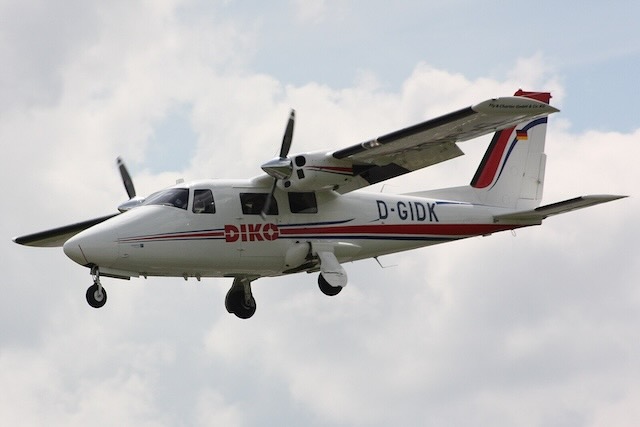P68
Summary
| Category | Military Transport Aircraft |
| Origin country | 🇮🇹 Italy |
| Manufacturer | Vulcanair |
| First flight | 25 May 1970 |
| Year introduced | 1971 |
| Number produced | 431 units |
Description
The Partenavia P.68 was conceived as a six-seat light transport and trainer aircraft. Designed by Luigi Pascale, it was initially manufactured by the Italian company Partenavia. The aircraft is a twin-engine, high-wing monoplane. Its design was submitted for type certification on January 22, 1969.
The prototype first flew on May 25, 1970, in Naples. The Italian Civil Aviation Authority granted type certification for the 9.20 m long P.68 on November 17, 1971, with a maximum takeoff weight of 1860 kg. The FAA approved the aircraft on December 7, 1971. Production commenced with 14 pre-production aircraft at new facilities in Casoria, Italy.
The Partenavia P.68 features a high-wing monoplane configuration and a fixed tricycle landing gear. The original variant is powered by two 200 hp Lycoming IO-360 engines. Later models, such as the P.68C-TC, feature turbocharged, 210 hp Lycoming TIO-360-C1A6D engines. Some variants, including the P.68R Victor and AP68TP-600 "Viator", incorporate retractable landing gear. The AP68TP-600 "Viator" is equipped with two 328 hp Allison 250-B17C turboprops. The P.68 Observer variant is characterized by a transparent fuselage nose and adapted systems for observation roles.
The Partenavia P.68 and its variants have been utilized by various military and civilian entities. Governmental users have included law enforcement agencies such as the Hesse State Police and the Italian State Police in Germany and Italy, respectively, and the National Police Air Service in the United Kingdom, for surveillance and patrol. In the United States, state agencies like the California Department of Fish and Game and the New York State Police have operated the type. International military and paramilitary operators have included the Royal Bahamas Defence Force, the Chilean Navy, and the Bophuthatswana Air Force. The aircraft's characteristics, such as good visibility and twin-engine configuration, have supported its deployment in observation, patrol, and light transport duties.
Main Variants:
-
P.68 Victor: The original variant is a twin piston engine, high-wing monoplane with fixed tricycle landing gear.
-
P.68B Victor: This is a longer variant of the P.68 Victor, offering more space in the cockpit.
-
P.68R Victor: Derived from the P.68B, this variant features a retractable landing gear.
-
P.68C: This variant includes a nose modified to accommodate weather radar, larger fuel tanks, and increased weights.
-
P.68 Observer: Derived from the P.68B, this observation aircraft variant features a transparent fuselage nose, adapted systems, and larger fuel tanks.
Technical specifications
| Version: P.68C | |
|---|---|
| Wing area | 18.6 m² (200.2 sqft) |
| Wingspan | 12 m (39.4 ft) |
| Height | 3.4 m (11.2 ft) |
| Length | 9.6 m (31.3 ft) |
| Service ceiling | 5,850 m (19,193 ft) |
| Empty weight | 1,230 kg (2,712 lbs) |
| Max. takeoff weight | 1,990 kg (4,387 lbs) |
| Climb rate | 7.6 m/s (24.9 ft/s) |
| Powerplant | 2 x pistons engine Lycoming AEIO-360-A1B6 delivering 149 kW each |


